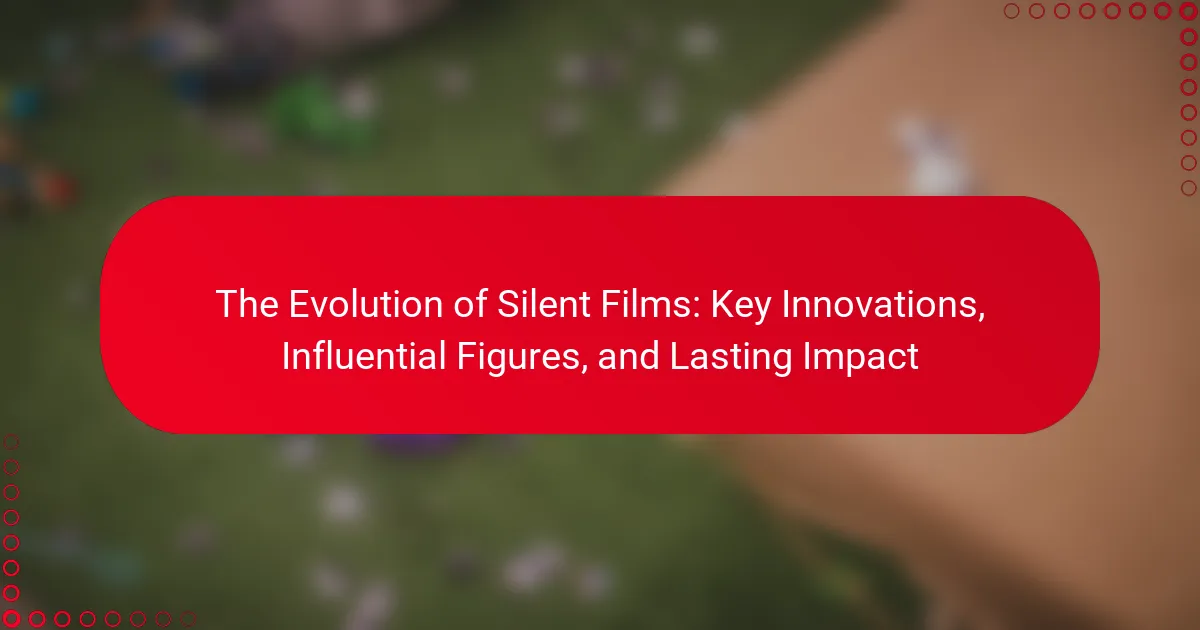The article explores the evolution of silent films, which are motion pictures characterized by the absence of synchronized sound or spoken dialogue, prevalent from the late 19th century to the late 1920s. It highlights key innovations that shaped this era, including narrative storytelling techniques, advancements in film technology, and the use of intertitles. Influential figures such as Charlie Chaplin, D.W. Griffith, and Buster Keaton significantly impacted the art of filmmaking, establishing foundational elements that continue to influence modern cinema. The legacy of silent films is examined, emphasizing their lasting impact on cinematic practices, particularly in visual storytelling and comedic expression.

What are Silent Films and How Did They Evolve?
Silent films are motion pictures without synchronized sound or spoken dialogue. They were prevalent from the late 19th century until the late 1920s. The first silent film is generally recognized as “Roundhay Garden Scene,” created in 1888. These films relied on visual storytelling, intertitles, and live music to convey narratives.
The evolution of silent films began with short clips and progressed to feature-length productions. Significant advancements included the introduction of narrative structure and innovative cinematography techniques. Pioneers like D.W. Griffith and Charlie Chaplin played crucial roles in developing the art form.
The transition to sound films, known as “talkies,” began with “The Jazz Singer” in 1927. This marked the decline of silent films as audiences favored synchronized sound. Despite this, silent films remain influential in film history and continue to be celebrated for their artistic contributions.
What defines a silent film?
A silent film is a motion picture that does not have synchronized sound or dialogue. Instead, it conveys its story through visual imagery, acting, and intertitles. Silent films were predominant from the late 19th century until the late 1920s. They relied heavily on expressive performances and visual storytelling techniques. Notable examples include “The Birth of a Nation” and “City Lights.” The absence of spoken words required filmmakers to innovate in visual communication. This era laid the groundwork for the development of sound films. Silent films are historically significant in the evolution of cinema.
What are the key characteristics of silent films?
Silent films are characterized by the absence of synchronized sound and dialogue. They primarily rely on visual storytelling, expressive acting, and intertitles for narrative clarity. The use of exaggerated [censured] expressions and body language is crucial for conveying emotions. Music often accompanies silent films, enhancing the mood and atmosphere. Cinematic techniques, such as close-ups and montage, are employed to create dramatic effects. The lack of spoken dialogue allows for universal themes, making them accessible to diverse audiences. Silent films were prominent from the late 19th century until the late 1920s, with significant contributions from filmmakers like Charlie Chaplin and D.W. Griffith. Their innovative storytelling techniques laid the groundwork for future cinematic developments.
How do silent films differ from sound films?
Silent films lack synchronized sound, while sound films incorporate dialogue and sound effects. Silent films rely on visual storytelling, using title cards and expressive acting to convey emotions. In contrast, sound films enhance storytelling through spoken dialogue, music, and sound effects. Silent films were predominant until the late 1920s. The transition to sound films began with “The Jazz Singer” in 1927, marking a significant technological shift. This change altered the filmmaking process, including scriptwriting, acting styles, and audience engagement. The introduction of sound revolutionized the film industry, leading to new genres and production techniques.
What historical context led to the rise of silent films?
The rise of silent films was influenced by technological advancements and cultural shifts in the early 20th century. The invention of the motion picture camera in the late 1890s allowed filmmakers to capture moving images. Early films were short and lacked synchronized sound, which led to the development of silent storytelling techniques. The popularity of vaudeville and theatrical performances created an audience accustomed to visual storytelling without dialogue. Additionally, the absence of sound technology made silent films a practical choice for filmmakers. As audiences embraced this new art form, studios began to invest in longer narratives and more complex productions. By the 1920s, silent films had become a dominant entertainment medium, leading to the establishment of Hollywood as the center of film production.
What technological advancements contributed to the creation of silent films?
The creation of silent films was significantly influenced by several technological advancements. The introduction of the motion picture camera allowed for the capture of moving images. Thomas Edison and his team developed the Kinetoscope in the late 1890s, enabling individual viewing of films. The use of celluloid film stock made it possible to record images more efficiently. Additionally, the development of film editing techniques allowed filmmakers to piece together scenes effectively. The invention of the projector facilitated public screenings of films for larger audiences. Innovations in lighting technology improved the visual quality of films. Finally, the introduction of intertitles provided narrative context, enhancing storytelling. These advancements collectively shaped the silent film era, laying the foundation for future cinematic developments.
How did societal factors influence the popularity of silent films?
Societal factors significantly influenced the popularity of silent films. The rise of urbanization in the early 20th century created a larger audience for films. Many people moved to cities, seeking entertainment options. Silent films offered a universal language, appealing to diverse populations. Economic factors also played a role; affordable ticket prices made films accessible to the masses. Additionally, the cultural context, including the influence of vaudeville, helped shape film content. The lack of synchronized sound technology further pushed filmmakers to create visually engaging narratives. Historical events, such as World War I, also shifted public interest towards escapism found in films. These societal dynamics collectively contributed to the widespread popularity of silent films during their era.

What Key Innovations Shaped the Silent Film Era?
Key innovations that shaped the Silent Film Era include the development of narrative storytelling techniques, advancements in film technology, and the use of intertitles. Narrative storytelling techniques allowed filmmakers to convey complex plots without sound. Pioneers like D.W. Griffith utilized editing methods to enhance emotional impact. Advancements in film technology, such as the introduction of the motion picture camera, enabled smoother and more dynamic scenes. The use of intertitles provided essential dialogue and context, guiding audience understanding. These innovations collectively transformed filmmaking and established a foundation for future cinematic developments.
What were the major technological innovations in silent filmmaking?
The major technological innovations in silent filmmaking include the development of the motion picture camera, editing techniques, and film stock improvements. The motion picture camera allowed filmmakers to capture moving images effectively. Early models, such as the Kinetoscope, were pivotal in this development. Editing techniques, like cross-cutting and parallel editing, enhanced storytelling. These techniques allowed filmmakers to create more complex narratives. Improvements in film stock increased sensitivity to light, enabling filmmakers to shoot in various lighting conditions. The introduction of synchronized sound technology, although not fully realized in silent films, laid groundwork for future advancements. These innovations collectively transformed filmmaking, influencing the art form significantly.
How did advancements in camera technology impact silent films?
Advancements in camera technology significantly enhanced the production quality of silent films. Improved camera mechanisms allowed for greater stability and clarity in shots. Innovations such as the introduction of the hand-cranked camera improved the ability to capture motion smoothly. The development of faster film stock increased the sensitivity to light, enabling filming in various lighting conditions. Additionally, advancements in lens technology expanded creative possibilities for filmmakers. These technical improvements contributed to more dynamic storytelling and visual artistry. For instance, the use of close-ups became more prevalent, allowing for deeper emotional engagement. Overall, camera technology advancements played a crucial role in shaping the silent film era’s artistic expression and audience experience.
What role did editing techniques play in the evolution of silent films?
Editing techniques were crucial in the evolution of silent films. They allowed filmmakers to create narrative coherence and emotional impact. Techniques such as cross-cutting and montage enabled simultaneous storytelling across different scenes. These methods enhanced pacing and built tension, engaging audiences more effectively. Early pioneers like D.W. Griffith utilized these techniques to convey complex narratives. Griffith’s film “The Birth of a Nation” showcased innovative editing that influenced future filmmakers. The development of editing also facilitated the transition from theatrical performances to cinematic storytelling. Overall, editing techniques significantly shaped the art of silent filmmaking, establishing foundational practices still used today.
How did the introduction of film techniques enhance storytelling?
The introduction of film techniques significantly enhanced storytelling by allowing for more dynamic visual narratives. Techniques such as close-ups, cross-cutting, and montage provided filmmakers with tools to convey emotions and build tension. Close-ups enabled audiences to connect with characters on a deeper level by displaying their [censured] expressions. Cross-cutting allowed for simultaneous storytelling, creating suspense by juxtaposing different scenes. Montage techniques facilitated the compression of time and space, effectively conveying complex ideas in a short duration. Historical examples include D.W. Griffith’s use of these techniques in “The Birth of a Nation,” which showcased innovative storytelling methods. These advancements transformed cinema into a more expressive art form, enriching the audience’s experience.
What specific techniques were developed during the silent film era?
The silent film era saw the development of several key techniques. These include title cards for dialogue and narration. Filmmakers used these cards to convey essential information. Another technique was the use of expressive acting. Actors relied on exaggerated [censured] expressions and body language to communicate emotions. Additionally, intertitles were strategically placed to enhance storytelling. The era also introduced innovative camera techniques. Techniques such as panning and tracking shots became more common. Editing techniques, including cross-cutting, helped to build suspense. These advancements laid the groundwork for modern filmmaking practices.
How did visual storytelling differ from narrative techniques in sound films?
Visual storytelling in silent films relied heavily on imagery and physical expression to convey emotions and plot. This approach emphasized visual cues, such as [censured] expressions and body language, to communicate narratives without dialogue. In contrast, narrative techniques in sound films incorporated spoken dialogue and sound effects, allowing for more complex storytelling. The introduction of synchronized sound changed the dynamics of character interaction and plot development. For instance, films like “The Jazz Singer” (1927) showcased the power of sound in enhancing emotional depth. This shift allowed filmmakers to explore subtler themes and character nuances that visual storytelling alone could not achieve.

Who Were the Influential Figures in the Silent Film Industry?
The influential figures in the silent film industry include Charlie Chaplin, D.W. Griffith, and Buster Keaton. Charlie Chaplin was known for his iconic character, the Tramp, and his ability to blend humor with social commentary. D.W. Griffith is credited with pioneering narrative techniques and editing styles that shaped modern filmmaking. Buster Keaton was celebrated for his physical comedy and innovative stunts. These individuals significantly impacted the art of storytelling in film. Their contributions established foundational elements of cinematic expression still used today.
Who were the pioneering filmmakers of silent cinema?
The pioneering filmmakers of silent cinema include D.W. Griffith, Georges Méliès, and Charlie Chaplin. D.W. Griffith is known for his innovative narrative techniques and the film “The Birth of a Nation.” Georges Méliès is celebrated for his imaginative storytelling and special effects in films like “A Trip to the Moon.” Charlie Chaplin brought character-driven comedy to the forefront with iconic films such as “The Kid.” These filmmakers significantly shaped the early film industry and established foundational techniques still used today.
What contributions did directors like D.W. Griffith make to silent films?
D.W. Griffith significantly advanced silent films through innovative narrative techniques. He introduced cross-cutting, which allowed simultaneous storytelling in different locations. This method enhanced dramatic tension and viewer engagement. Griffith also pioneered the use of close-ups to convey character emotions. His film “The Birth of a Nation” (1915) showcased these techniques on a grand scale. It was one of the first feature-length films, running over three hours. Griffith’s work set new standards for film production and storytelling. His techniques influenced countless filmmakers and shaped the future of cinema.
How did actors and actresses shape the silent film landscape?
Actors and actresses significantly shaped the silent film landscape through their expressive performances. Their ability to convey emotions without dialogue was crucial for storytelling. Iconic figures like Charlie Chaplin and Mary Pickford became symbols of the era. Chaplin’s comedic genius brought humor and depth to silent narratives. Pickford’s charm and talent helped to popularize the star system. The physicality of performances became a vital form of communication. Audiences connected with characters through visual cues and body language. This reliance on expression set the foundation for future cinematic techniques. Silent film actors influenced the development of character-driven stories that remain relevant today.
What impact did composers have on the silent film experience?
Composers significantly enhanced the silent film experience by providing emotional depth and narrative context. Their music guided audience reactions and complemented the visual storytelling. For instance, composers like Carl Davis and Max Steiner created scores that synchronized with on-screen action. This synchronization heightened tension during dramatic scenes and evoked laughter during comedic moments. The absence of spoken dialogue made music essential for conveying mood and character emotions. Historical records show that live orchestras performed during screenings, further immersing viewers in the film. This practice established a precedent for film scoring that continues today. Overall, composers transformed silent films into a more engaging and expressive medium.
How did music enhance the emotional depth of silent films?
Music enhanced the emotional depth of silent films by providing an auditory context that complemented the visual storytelling. It helped convey the characters’ emotions, moods, and themes. For instance, a dramatic score could heighten tension during critical scenes. Conversely, a light-hearted melody could evoke joy in comedic moments. The absence of spoken dialogue made music essential for audience engagement. Specific compositions were often tailored to match the film’s narrative arc. Historical examples include the use of orchestras in theaters to accompany films like “The Birth of a Nation” and “The Cabinet of Dr. Caligari.” These practices established a connection between the audience and the film, making the emotional experience more profound.
Who were some notable composers associated with silent films?
Notable composers associated with silent films include Carl Davis, Max Steiner, and Erich Wolfgang Korngold. Carl Davis composed scores for films such as “The Adventures of Prince Achmed.” Max Steiner is known for his work on “King Kong” and “Gone with the Wind.” Erich Wolfgang Korngold’s compositions for “The Adventures of Robin Hood” were groundbreaking. These composers significantly contributed to the development of film music during the silent era. Their scores enhanced the emotional depth of the films and set a precedent for future film scoring.

What is the Lasting Impact of Silent Films on Cinema Today?
Silent films have a profound and lasting impact on cinema today. They established foundational storytelling techniques that remain relevant. Techniques such as visual storytelling and the use of expressive acting were pioneered during this era. Filmmakers learned to convey emotions without dialogue, relying on visuals and music. This approach influences modern cinema, especially in genres like animation and action. Iconic directors like Charlie Chaplin and Buster Keaton set standards for comedic timing and physical comedy. Their influence is evident in contemporary films that prioritize visual humor. Additionally, silent films emphasized the importance of cinematography and editing, shaping modern filmmaking practices. The legacy of silent films continues to inspire filmmakers, ensuring their techniques are integrated into today’s cinematic language.
How did silent films influence modern filmmaking techniques?
Silent films significantly influenced modern filmmaking techniques by establishing foundational storytelling methods. They relied heavily on visual expression and body language to convey emotions and narratives. This emphasis on visual storytelling is still prevalent in contemporary cinema. Silent films also pioneered techniques such as montage, which is used to create emotional resonance and narrative depth. Directors like D.W. Griffith developed editing techniques that enhanced pacing and narrative structure. The use of title cards in silent films laid the groundwork for dialogue integration in modern films. Additionally, the necessity for compelling visuals in silent films spurred innovations in cinematography and lighting. These early practices have become essential elements in today’s filmmaking.
What elements of silent films are still present in contemporary cinema?
Visual storytelling remains a key element of contemporary cinema, rooted in silent films. This technique relies on imagery to convey emotions and narratives without dialogue. Additionally, expressive acting is still prominent today, as performers use body language and [censured] expressions to communicate. The use of title cards for context or humor also persists, albeit in modern forms like subtitles or on-screen text. Furthermore, musical scores continue to play a vital role, enhancing the emotional experience, similar to how they accompanied silent films. Finally, the influence of genre conventions from silent films, such as slapstick comedy and melodrama, can be observed in modern filmmaking. These elements demonstrate the lasting legacy of silent cinema in today’s film industry.
How have silent films shaped the way stories are told in film?
Silent films have significantly shaped storytelling in modern cinema. They relied on visual cues, expressions, and gestures to convey emotions and narratives. This emphasis on visual storytelling laid the groundwork for the importance of cinematography. Techniques such as montage and close-ups were pioneered during the silent era. Filmmakers like D.W. Griffith introduced innovative editing methods that enhanced narrative flow. The use of intertitles to convey dialogue and exposition also emerged. This practice influenced how dialogue is integrated into films today. Silent films taught filmmakers to show rather than tell, a principle that remains vital in visual storytelling. Overall, the techniques and approaches developed in silent films continue to impact narrative structures in contemporary cinema.
What lessons can filmmakers learn from the silent film era?
Filmmakers can learn the importance of visual storytelling from the silent film era. Silent films relied heavily on imagery to convey emotions and narratives. Directors like Charlie Chaplin and D.W. Griffith mastered the art of visual expression. They used [censured] expressions and body language to communicate complex ideas without dialogue. This teaches modern filmmakers to focus on visuals and non-verbal cues. Additionally, silent films often employed innovative editing techniques. Techniques such as cross-cutting and close-ups enhanced storytelling. Filmmakers today can apply these techniques to create more engaging narratives. The silent film era also emphasized the significance of pacing. Maintaining rhythm in storytelling keeps audiences captivated. These lessons remain relevant in contemporary filmmaking practices.
How can modern filmmakers apply silent film techniques to enhance their work?
Modern filmmakers can apply silent film techniques to enhance their work by utilizing visual storytelling. This method emphasizes strong imagery and expressive acting to convey emotions without dialogue. Filmmakers can also employ exaggerated [censured] expressions and body language, which were essential in silent films, to communicate character motivations clearly.
Additionally, the use of title cards can provide context and enhance narrative flow. Incorporating techniques such as montage editing can create emotional resonance, similar to how silent films built tension and drama.
Furthermore, filmmakers can draw inspiration from the pacing of silent films, allowing scenes to breathe and giving audiences time to absorb visual cues. The reliance on atmospheric music, a hallmark of silent cinema, can also enrich the viewing experience by setting the tone.
Historical examples, like Charlie Chaplin’s work, showcase how these techniques effectively engage audiences. By blending these silent film methods with modern technology, filmmakers can create unique and impactful narratives.
What are best practices for incorporating visual storytelling in film today?
Best practices for incorporating visual storytelling in film today include utilizing strong imagery and symbolism. Filmmakers should focus on visual metaphors to convey emotions and themes. This enhances audience engagement and understanding. Effective use of color palettes can evoke specific feelings and set the tone. Additionally, framing and composition guide viewer attention to key elements. Dynamic camera movements can create a sense of action and urgency. Moreover, incorporating visual motifs throughout the film adds depth and coherence to the narrative. Finally, collaboration with skilled cinematographers ensures that the visual elements align with the story’s vision.
The main entity of the article is silent films, which are motion pictures without synchronized sound or spoken dialogue, prevalent from the late 19th century until the late 1920s. The article explores the evolution of silent films, highlighting key innovations in storytelling techniques, cinematography, and editing that shaped the medium. It discusses influential figures such as D.W. Griffith, Charlie Chaplin, and Buster Keaton, who contributed significantly to the art form. Additionally, the lasting impact of silent films on modern cinema is examined, including their influence on visual storytelling and filmmaking techniques still utilized today.
